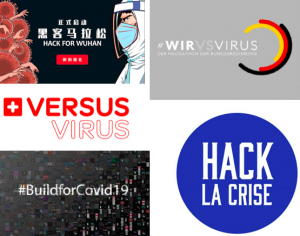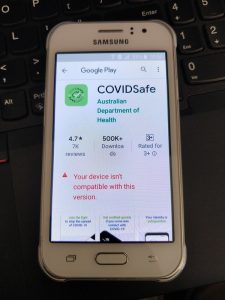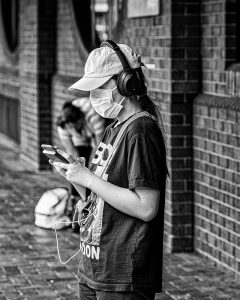Cornelius Heimstädt and Morgan Meyer
While the fight against Covid-19 mobilizes medicine, science and politics, it also involves a wide array of technological entities, such as apps. Apps can make life in domestic quarantine more bearable by providing opportunities for yoga, fitness, streaming, online dating, video calling, games or education. They can also provide access to practical tips, medical advice, or psychological support, difficult to access otherwise. They can also play a role in the ending and easing of lockdowns.
Throughout the Covid-19 pandemic, apps have multiplied to fix vulnerabilities of our bodies and our societies. Despite these vulnerabilities, we need to develop robust intellectual capacities to think about and think through these apps. This is because apps are not neutral devices that, once used, have no lasting effects on our modes of life. They change the way we see, navigate, and communicate in social spaces and they raise issues about politics, markets, justice, access, and power.
Civic hackers: patching public infrastructures
Since the beginning of the pandemic, numerous hackathons have been organized to offer concerned citizens the opportunity to engage in the fight against Covid-19. Under titles like Hack for Wuhan (27-28 february, China), Hack la Crise (20-22 march, France), #WirVsVirus (20-22 march, Germany), #BuildforCOVID19 (26-30 march, global), Versus Virus (3-5 april, Switzerland) and many more, thousands of projects to fight the pandemic have been created in a fairly short period of time. Out of the twenty awarded projects of the #WirVsVirus hackathon, we can mention for example “Sichtertest”, to facilitate online bookings of corona test appointments, “Small Business Hero”, a platform to connect owners of small shops with local residents, and “JAY”, to mediate jobs during the Covid-19 pandemic and afterwards.

Scholars have been studying the phenomenon of hackathons for several years, pointing at the way in which they envision the solution of societal problems by technical means[1]. Some have argued that “[p]articipants in hackathons imagine themselves as agents of social progress through software” while pointing out that “these middle-class efforts to remake culture draw legitimacy from the global prestige of technology industry work practices”[2]. Other scholars take a less critical stance towards the participation in hackathons and argue that “[d]espite their fetish for speed (in rapid production and hackathons), civic hackers often act as the ‘slow food movement’ of digital political action, embracing local sourcing, ethical consumption, and pleasure of community work.”[3]
Three dynamics are particularly noteworthy these days. First, the temporality of the hackathons: there is a strong sense of urgency and an emphasis on the need for quickly translating projects into usable solutions. Second, the hackathons are almost all purely online, with the biggest ones bringing together tens of thousands of participants from across the world. Third, many of the projects developed are apps.
Apps serve as devices to quickly formalize responses. The apps created during hackathons cater for a variety of needs such as health, commerce, or unemployment. They are envisioned to form an emergency infrastructure or at least to bridge gaps and bottlenecks in existing infrastructures (shortages of food, products, mutual aid, etc.). Yet as “app studies” scholars have shown, apps are no ready-made technologies and rely on complex infrastructures themselves[4]. As an app grows out of the idea stage, it needs to be maintained, financed, and secured. A look at commercial app developers and how they respond to Covid-19 helps to better understand these issues.
Scaling app traffic
Covid-19 has a strong influence on the business models of existing app developers: Apple, Google and Amazon ban “nonofficial coronavirus apps” from their app stores to take action against fake news. The value of the Uber share has fallen steeply so that the company created a “work hub” to provide other kinds of gig jobs to its drivers.

A particularly interesting example of these changes is the strong increase in the number of daily users of the video conferencing system Zoom (which also exists as an app) and the associated increase in the value of the company. This unexpected growth is accompanied by strong criticism of the software’s technical flaws. The many problems “make a billion-dollar publicly traded company seem like it’s held together with duct tape and string.”[5] In a blog post, the CEO of Zoom apologized to its users and promised immediate adjustments.
Apart from these dramatic ups and downs of big app developers, many smaller companies adapt their strategies or business models to the current situation. Numerous apps or premium features, one had to pay before the Covid-19 pandemic, are now offered free of charge. Why do app developers do that? For venture capitalists, the “bad news“ is that “[a]s consumers curtail their discretionary spending, in-app purchases and subscriptions will likely be impacted.” But there is also “good news”: “Achieving user-growth will become cheaper.”[6] Put differently, app developers are advised to take advantage of the crisis by investing in making more people download their apps and making those users spend more time with their apps. Besides commercial apps, free and open source systems (i.e. the videoconferencing platform Jitsi Meet) have also seen positive developments: difficulties to cope with the increase of users have led to donations, support from companies, and, eventually, an improved product.
For existing apps, the Covid-19 pandemic has thus two noteworthy effects. One effect is scaling: the quantity of users is significantly increasing (or decreasing). And with new users and more data traffic, come questions of privacy, quality, and reputability. Another effect is that of changing economics. We see companies and developers providing services for free, lowering prices, seeking new business ventures, collaborations, and donations. While apps still generate value from a combination of users, subscriptions and data flows, the Covid-19 pandemic is revaluing and rearranging these elements in new ways.
The politics of tracking apps

The apps that currently yield most debate are apps for tracking Covid-19. They are, in a sense, “un-dating” apps, the opposite of what many apps try to do in normal times: connecting people. Many governments are reflecting on their use. On the one hand, these apps can be a means to bring together two imperatives: allowing people to move freely and, at the same time, breaking chains of infection (by enabling those people who have been in contact with someone infected to be tracked down). On the other hand, the use of such apps is problematic for various reasons. Mass surveillance, infringement of data protection laws, protection of privacy, user choice: the political and regulatory dimensions are currently debated. There are also technical difficulties: the difficulty to assess the exact distance between mobile phone users via Bluetooth, the problem of interoperability between different systems, the choice between centralized and decentralized systems, and many others.
Besides these controversies unfolding between public authorities, scientists, and activists, companies have already started to develop their own tracking technologies. Apple and Google have paired up to develop a system that, they argue, will be “anonymous”, and will care for “privacy, transparency and consent”. Some countries are already using their own systems: Taiwan has built an “electric fence”, which, when broken (people leaving their house or turning their smartphone off) is reported to the police, and Poland’s “home quarantine app” requires quarantined persons to record selfies at home. Moscow’s “social monitoring” app has been the object of intense critique. Depending on the country and context, tracking apps exercise different kinds of politics. It is not only the technology as such, but the entanglements of technology, the state, the law and the body, that need to be put into public scrutiny.
What futures for apps?
The Covid-19 pandemic reveals the collective and temporal dynamics of apps: the context of urgency in which they are developed, the pace at which they appear, the abrupt changes of their business models, and the adaptability of their performance indicators. These dynamics also concern the future: What kinds of effects and uses will remain once the pandemic is over? What will remain from the interfaces and infrastructures envisioned, the ideas of how to tackle the pandemic, the new communities of users, the transformations regarding how our bodies are dis/connected to our environments? What do these apps become?
One thing is for sure: apps do not magically endure over time; they need to be actively maintained, fixed, moderated, and updated. All this work remains largely absent in current discussions, but for those apps that will be developed, all this invisible – and sometimes inglorious – work will need more serious consideration.
Thinking about apps takes time. We need to resist the current pace, urgency and presentism of app economies. We need to take time to historicize, theorize, politicize, compare, and contrast. If apps are there to stay with us as parts of our lives – and this seems likely[7]– we need to take them seriously, slowly.[8]
Paper published in CNRS Le Journal in April 2020
[1] Ermoshina, K., Is there an App for everything? Potentials and limits of civic hacking, Observatorio, vol.10, 2016, p.116-140.
[2] Irani, L., Hackathons and the making of entrepreneurial citizenship, Science, Technology & Human Values, vol.40, n°5, 2015, p.799-824.
[3] Schrock, A. R., Civic hacking as data activism and advocacy: A history from publicity to open government data, New Media & Society, vol.18, n°4, 2016, p.581-599.
[4] Dieter, M. et al., Multi-Situated App Studies: Methods and Propositions, Social Media+ Society, vol.5, n°2, 2019.
[5] Is it safe to use zoom?, Intelligencer, 9 avril 2020.
[6] App developers in post-Covid world: A bleak future, rife with opportunity, VB, 4 avril 2020.
[7] See Dagiral, E., Martin, O. (2020) Le numérique au centre de nos vies confinées. CNRS Le Journal, 10 april.
[8] The authors would like to thank Ksenia Ermoshina and Jérôme Denis for their comments and feedback.
Photo #1: “Hackathons”, February-April 2020.
Photo #2 credit: Alpha, “COVIDSafe – Your device isn’t compatible“, April 2020. CC BY-NC 2.0
Photo #3 credit: Chris (a.k.a. MoiVous), “Battery“, March 2020. CC BY-NC-ND 2.0

